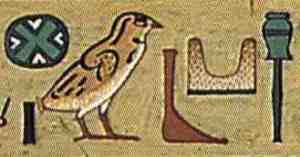It’s the fourteenth post, and time to visit my favourite temple, Abydos, via the third of Osiris’ titles in this formula:


neb Abdju, Lord of Abydos.
We’ve done neb, haven’t we? We can get straight on to Abdju:


Just for a change, I thought we’d compare handwritten hieroglyphs and the more detailed painted hieroglyphs for the whole word side by side. They’re facing in opposite directions, but that’s not going to bother experienced office scribes, is it? And I know you’re going to take the spelling variation in your stride. As for the slightly different arrangement of hieroglyphs for the sake of artistic balance – pah! We laugh in its face.
OK, let’s do a bit of dissection.
![]()

The first sign is – well, no-one’s quite sure, but it could be a chisel. In which case, the blade is probably the wide, flat bit that looks like the handle. It’s painted green in the inscription on the right, which would figure if it were copper or bronze . (Almost the whole of the Pharaonic Period, took place in the Bronze Age in Egypt – something to contemplate while you’re waiting for that response from the IT helpdesk.) The horizontal lines in the painted version may be cords lashing the blade to the handle.
So, when you’re drawing it, you need to draw a shape something like a short, wide vase or jar, then add a long thin shaft to the bottom.
The second sign (or the third sign in the painted version)
![]()
![]()
is a reinforcement of the b already present in Ab. It’s a human foot, and in the second version painted the normal colour used for male skin in ancient Egypt – a dark, suntanned he-man red. Ladies (and, in later periods, privileged men like scribes who worked indoors), were painted a pale yellow.
When you’re drawing your foot, give him a straight shin, an indication of the toes and heel and maybe a bit of instep – unlike the painted one, which seems to be flat-footed. I know what that’s like and it’s cruel, so be kind to your hieroglyphs and don’t deform them (unless you’re writing them for someone ina traditionally flat-footed profession, like the police).
Which brings us to the third sign (or second in the alternative version)
![]()

dju. See how the artist in the painted inscription has given it a reddish, speckled, grainy appearance above a thick, dark baseline? That is because the dju hieroglyph is a depiction of the desert hills rising above the fertile plain of the Nile. And the gap between the hills is where the sun would rise above or set below the horizon. (The two pylons of a temple and the gap of the gateway also represent this idea.)
Finally, some familiar signs to complete the word; the cute little quail chick reinforcing the u sound of dju in the painting; the city or village determinative, and the single stroke, as much to fill an otherwise empty space as for any other reason.
Abdju, or Abydos, was the major cult centre of Osiris in Upper Egypt, or the Nile Valley.
It’s not as easy to get there as it used to be, for security reasons, and there are restrictions on how long you can stay (nowhere near long enough) but it’s the most wonderful place.
For one thing, it’s very ancient. There are royal tombs out in the desert which date back to around the time of the unification of Egypt – the tombs of several “he of the sedges”. In later times, the Egyptians believed that one of them was the tomb of Osiris himself, and it became a place of pilgrimage for people from all over the country. There was a huge festival there every year, where mystery plays re-enacting the death and resurrection of Osiris and the battles of Horus and Seth were performed. People came from far and wide to be part of them.
Kings built magnificent temples to Osiris there: the temple of Seti I is just about the only Pharaonic temple of any size with it roof intact. This plus the fact that the Christians whitewashed over the walls meant sthat the colours of the reliefs are the best preserved of any Egyptian temple – and Seti I went for quality; just compare them with his son Ramesses II’s temple next door – even allowing for the fat that the roof is gone, there’s no comparison really. Behind the Seti I temple is a highly intrguing underground temple called the Osireion, with an island in an underground lake, and…
Oh, I can’t wait to go back!. Go, go, go!